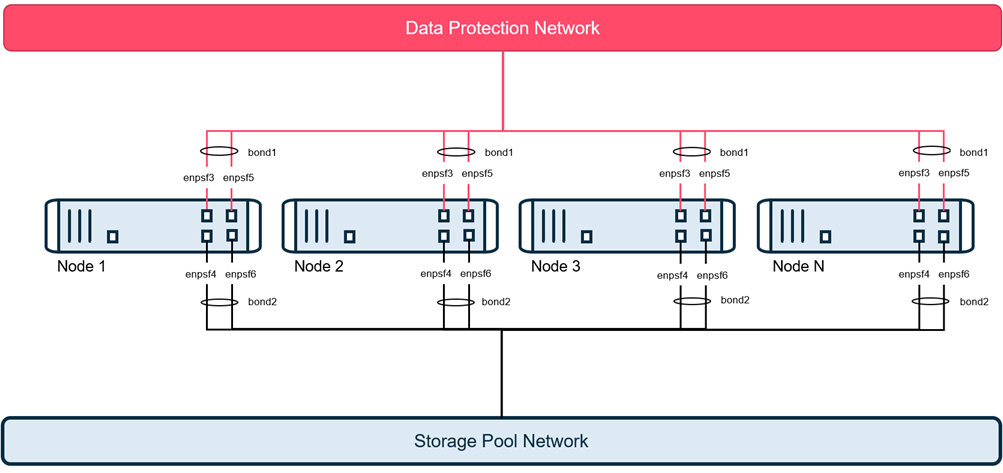Bonded topology is the most common option for HyperScale as this provides network level redundancy for each node.
In this topology, each node requires connections to 2 separate network as follows:
-
2 - 10 GbE port for data protection network, which transfers data to and from the clients being protected and connect to the CommServe server.
-
2 - 10 GbE port for storage pool network, which is a dedicated private network, used for communication and replication between the HyperScale nodes.
Note
Bonded topology is the most used configuration and is recommended for most deployments. The bonding can be configured to provide redundancy using either the Active-Backup bonding or the Link Aggregation Control Protocol (LACP). This can also be used with a multi-switch link aggregation protocol such as Virtual Port Channel (VPC), MLAG, or MC-LAG to provide switch level redundancy.

-
Each pair will be bonded on the node, so it is treated as one logical connection. If a node encounters a cable, SFP, or network card failures, the node remains operational without any user intervention. This can optionally be setup to connect to 2 switches to provide switch level redundancy.
-
Active-Backup and Link Aggregation Control Protocol (LACP) are the supported bonding modes.
LACP requires the switch(s) to support it as well. When using LACP, each pair of ports should be configured as an active port-channel, and not configured to negotiate the aggregation protocol.
Network Requirements
In this topology, each node requires the following connections:
-
2 - 10 GbE bonded ports for the data protection network, which transfers data to and from the clients. This requires a corresponding IP address for the data protection network.
-
2 - 10 GbE bonded ports for the storage pool which is a dedicated private network, used for communication and replication between the HyperScale nodes. This requires a corresponding IP address for the storage pool network.
Note
Data Protection and storage pool networks MUST be on two separate subnets.
The following network names and IP addresses are required for a bonded topology:
|
Node 1 |
Node 2 |
Node 3 |
Node n |
|
|---|---|---|---|---|
|
Data Protection Fully Qualified Domain Name* |
|
|
|
|
|
Data Protection IP Address* |
|
|
|
|
|
Data Protection Netmask* |
|
|
|
|
|
Data Protection Gateway* |
|
|
|
|
|
Data Protection DNS 1* |
|
|
|
|
|
Data Protection DNS 2 |
|
|
|
|
|
Data Protection DNS 3 |
|
|
|
|
|
Storage Pool IP Address* |
|
|
|
|
|
Storage Pool Netmask* |
|
|
|
|
|
Data Protection Network Interface MAC 1 (OS Port Name 1) |
|
|
|
|
|
Node Data Protection Network Interface MAC 2 (OS Port Name 2) |
|
|
|
|
|
Storage Pool Network Interface MAC 1 |
|
|
|
|
|
Storage Pool Network Interface MAC 2 |
|
|
|
|
* Required fields Each node should be resolvable to the CommServe server.
Note
If you have more than 3 nodes expand the columns in this table to include all the nodes that you plan to setup.
CommServe Requirements
You will require the following information to connect to an existing CommServe server:
|
CommServe hostname (FQDN) |
Fully qualified hostname (FQDN) associated with the existing CommServe server. Note TCP Ports 8400 & 443 must be open from the nodes to the CommServe server. |
|
Username |
Username associated with the admin user. |
|
Password |
Password for the admin user. |
